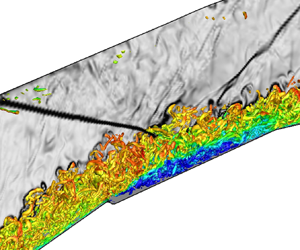Article contents
Flow instabilities and impact of ramp–isolator junction on shock–boundary-layer interactions in a supersonic intake
Published online by Cambridge University Press: 09 December 2022
Abstract

Boundary layer instabilities and shock–boundary-layer interactions (SBLIs) critically affect the performance and safe operation of mixed-compression air intakes. We present a computational study anchored in companion experiments, to evaluate the multimodal mechanisms driving the dynamics of the external compression ramp flow and the cowl SBLI in a Mach  $3$ intake. Boundary layer transition over the external ramp is first analysed through a global linear analysis, and the linear estimates are further validated through direct numerical simulations. The separation bubble over the ramp harbours three-dimensional stationary instabilities that induce transition, under the influence of secondary instabilities driven by the shear layer modes of the bubble. The interaction of the resulting turbulized boundary layer with the cowl shock at the ramp–isolator junction and its control through geometrical modification constitutes the second part of the study. We tested a faceted (baseline) and a notched (modified) junction design to evaluate its impact on the low-, mid- and high-frequency scales generated at the cowl SBLI region. In relation to the baseline case, the notched geometry effectively locks the separation point of the bubble, thus attenuating the upstream low-frequency breathing motion. The notch also energizes the midfrequency content through vortex shedding in a well-developed shear layer, which persists into the isolator, thus assisting in an efficient compression process through cross-stream mixing of near-wall flow. The isolator boundary layer in the notched design exhibits relatively lower static pressures and higher velocity fluctuations, which are conducive to improving the flow stability, unstart margin and efficiency of high-speed propulsion systems.
$3$ intake. Boundary layer transition over the external ramp is first analysed through a global linear analysis, and the linear estimates are further validated through direct numerical simulations. The separation bubble over the ramp harbours three-dimensional stationary instabilities that induce transition, under the influence of secondary instabilities driven by the shear layer modes of the bubble. The interaction of the resulting turbulized boundary layer with the cowl shock at the ramp–isolator junction and its control through geometrical modification constitutes the second part of the study. We tested a faceted (baseline) and a notched (modified) junction design to evaluate its impact on the low-, mid- and high-frequency scales generated at the cowl SBLI region. In relation to the baseline case, the notched geometry effectively locks the separation point of the bubble, thus attenuating the upstream low-frequency breathing motion. The notch also energizes the midfrequency content through vortex shedding in a well-developed shear layer, which persists into the isolator, thus assisting in an efficient compression process through cross-stream mixing of near-wall flow. The isolator boundary layer in the notched design exhibits relatively lower static pressures and higher velocity fluctuations, which are conducive to improving the flow stability, unstart margin and efficiency of high-speed propulsion systems.
- Type
- JFM Papers
- Information
- Copyright
- © The Author(s), 2022. Published by Cambridge University Press
References
REFERENCES
- 4
- Cited by





